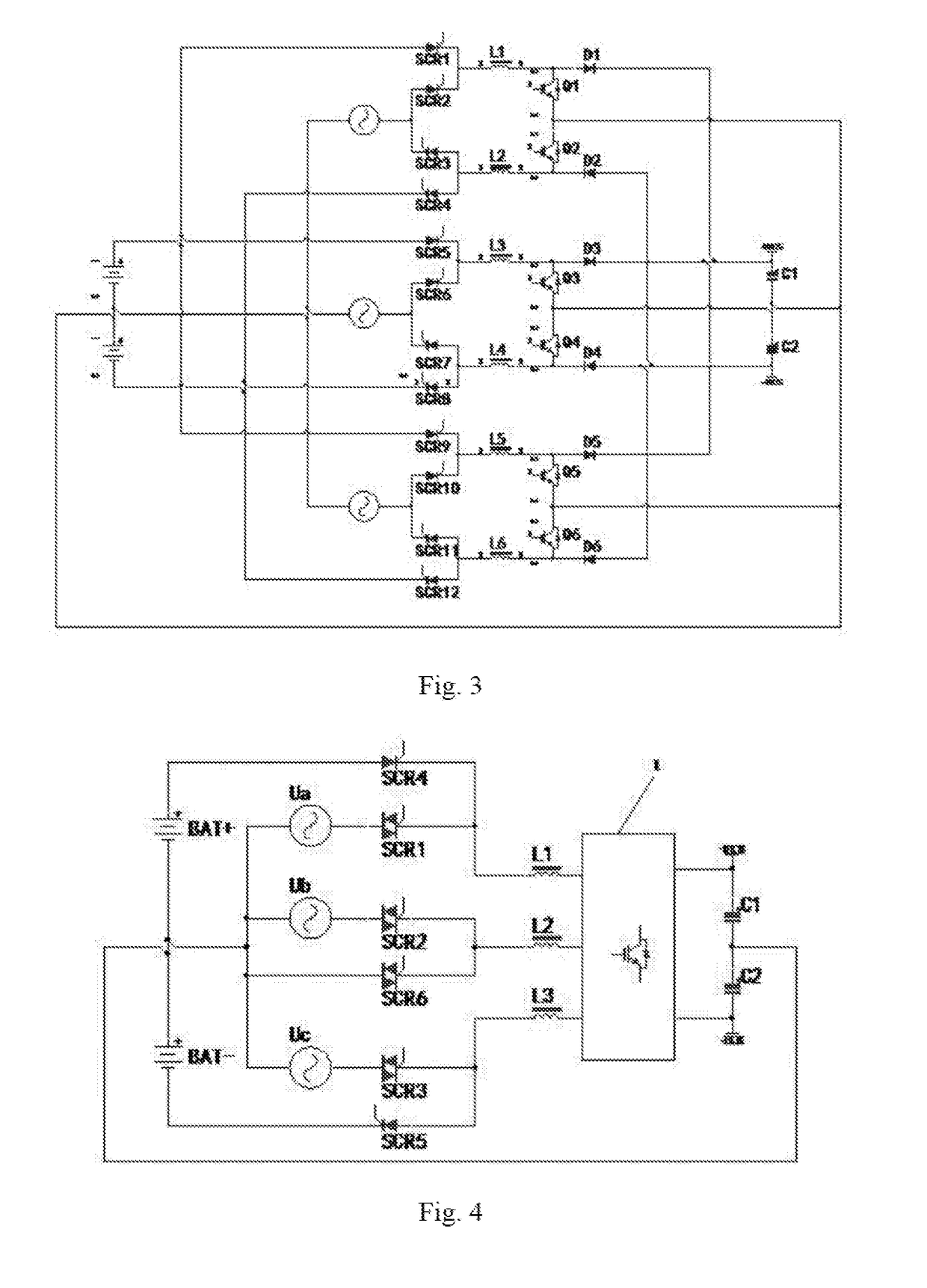Three-phase boost rectifier circuit and control method thereof, and an uninterrupted power supply
a rectifier circuit and three-phase technology, applied in emergency power supply arrangements, power conversion systems, electrical equipment, etc., can solve the problems of reducing the reliability of the boost in battery state, increasing the cost and circuit complexity, and reducing the efficiency of the boost under battery sta
- Summary
- Abstract
- Description
- Claims
- Application Information
AI Technical Summary
Benefits of technology
Problems solved by technology
Method used
Image
Examples
embodiment 1
[0064]As shown in FIG. 4, a three-phase boost rectifier circuit, comprising positive battery packs BAT+, second battery packs BAT−, and a boost rectifier module; the boost rectifier module comprising a first bidirectional thyristor SCR1, a second bidirectional thyristor SCR2, a third bidirectional thyristor SCR3, a fourth bidirectional thyristor SCR6, a first unidirectional thyristor SCR4, a second unidirectional thyristor SCR5, a first inductor L1, a second inductor L2, a third inductor L3, a three-phase fully controlled rectifier bridge, a first capacitor C1, a second capacitor C2; one end of the first bidirectional thyristor SCR1, one end of the second bidirectional thyristor SCR2 and one end of the third bidirectional thyristor SCR3 are respectively connected to the first phase of three-phase power, the second phase of three-phase power and the third phase of three-phase power; the anode of the first unidirectional thyristor SCR4 and the cathode of the second unidirectional thyr...
embodiment 2
[0090]As shown in FIG. 19, this embodiment provide a three-phase boost rectifier circuit, comprising positive battery packs BAT+, second battery packs BAT−, and a boost rectifier module; the boost rectifier module comprising a first bidirectional thyristor SCR1, a second bidirectional thyristor SCR2, a third bidirectional thyristor SCR3, a fourth bidirectional thyristor SCR6, a first unidirectional thyristor SCR4, a second unidirectional thyristor SCR5, a first inductor L1, a second inductor L2, a third inductor L3, a three-phase fully controlled rectifier bridge, a first capacitor C1, a second capacitor C2; one end of the first bidirectional thyristor SCR1, one end of the second bidirectional thyristor SCR2 and one end of the third bidirectional thyristor SCR3 are respectively connected to the first phase of three-phase power, the second phase of three-phase power and the third phase of three-phase power; the anode of the first unidirectional thyristor SCR4 and the cathode of the s...
embodiment 3
[0092]As shown in FIG. 20, this embodiment provide a three-phase boost rectifier circuit, comprising positive battery packs BAT+, second battery packs BAT−, and a boost rectifier module; the boost rectifier module comprising a first bidirectional thyristor SCR1, a second bidirectional thyristor SCR2, a third bidirectional thyristor SCR3, a fourth bidirectional thyristor SCR6, a first unidirectional thyristor SCR4, a second unidirectional thyristor SCR5, a first inductor L1, a second inductor L2, a third inductor L3, a three-phase fully controlled rectifier bridge, a first capacitor C1, a second capacitor C2; one end of the first bidirectional thyristor SCR1, one end of the second bidirectional thyristor SCR2 and one end of the third bidirectional thyristor SCR3 are respectively connected to the first phase of three-phase power, the second phase of three-phase power and the third phase of three-phase power; the anode of the first unidirectional thyristor SCR4 and the cathode of the s...
PUM
 Login to View More
Login to View More Abstract
Description
Claims
Application Information
 Login to View More
Login to View More - R&D
- Intellectual Property
- Life Sciences
- Materials
- Tech Scout
- Unparalleled Data Quality
- Higher Quality Content
- 60% Fewer Hallucinations
Browse by: Latest US Patents, China's latest patents, Technical Efficacy Thesaurus, Application Domain, Technology Topic, Popular Technical Reports.
© 2025 PatSnap. All rights reserved.Legal|Privacy policy|Modern Slavery Act Transparency Statement|Sitemap|About US| Contact US: help@patsnap.com



